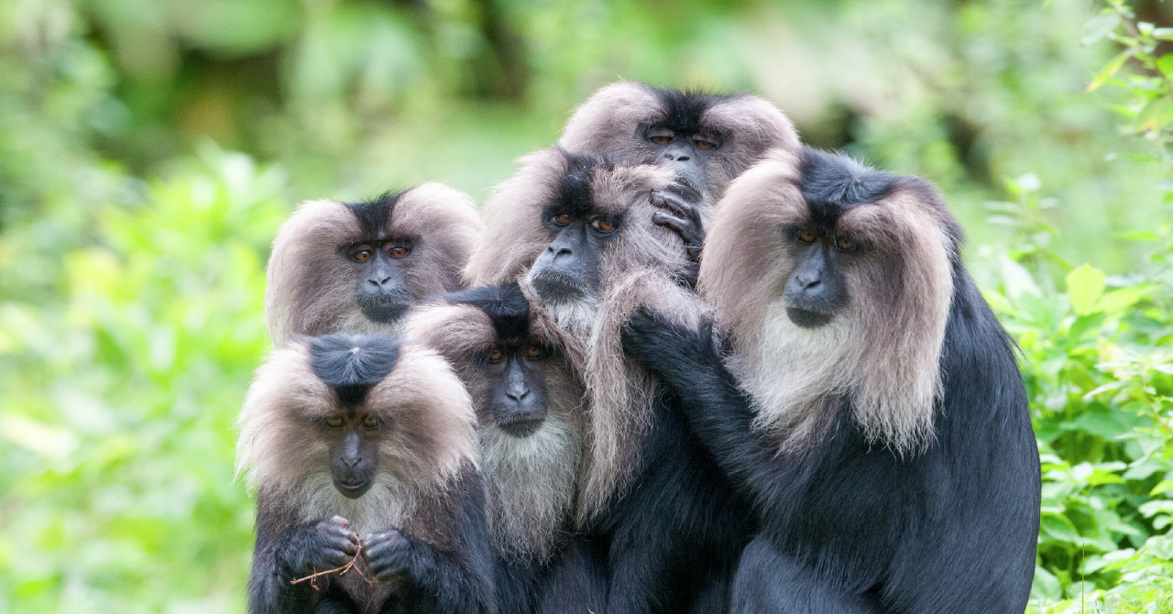Lion-Tailed Macaque
Macaca silenus
Habitat
Tropical rainforest
Food
Fruit, seeds, leaves
Weight
♂ 5-10 kg | ♀ 2-6 kg
Age
20 to 35 years
IUCN Status
Bedreigd
Appearance
Lion-tailed macaques have black fur. They are characterised by the grey mane around their face. In fact they are sometimes called bearded monkeys. They have a small tuft on the tip of their tail. Their tail resembles a lion’s tail which is where the name ‘lion-tailed macaque’ comes from. Lion-tailed macaque males are larger than the females. Just like other macaques, these monkeys also have cheek pouches. The pouch holds almost as much food as can fit in their stomach and they use their pouches to temporarily store food. Finally, just like other Old World monkeys, lion-tailed macaques have a tough, callous-like pad of skin on their buttocks, enabling them to sit and sleep on tree branches.
Habitat
In the wild, lion-tailed macaques are only native to the south-west of India. There, they live in the Western Ghats hills and mountains of South-western India, where they live in tropical rainforests and on elevated mountainsides.
Lifestyle
Lion-tailed macaques are social animals, living in groups of four to thirty animals. Each group consists of a few adult males and roughly twice as many females and infants. One of the males is the alpha male and leader of the group. Males often change groups. That means they join another existing group and establish themselves by means of a hostile takeover. Each individual animal knows its place in the group, which maintains a distinct hierarchy. The males do not have much contact with each other and often remain at a distance. The females stay within the group and adhere to a clear, linear hierarchy.
Behaviour
Lion-tailed macaques use some seventeen different vocal calls to communicate with each other. They also communicate a lot through facial expressions and posture. Their tail is also a major component of their communication. Dominant animals hold their tail straight up, whereas animals who are lower in the hierarchy or are anxious, keep their tails hanging down. Lion-tailed macaques are very territorial. Every now and then males will emit a loud call, telling the other animals where they are and what their territory is. During the day, lion-tailed macaques are busy foraging for food. They fill their big cheek pouches with food. Later, when things are calmer, they eat their food. They rub their hand over their cheek to release the food stored there.

Reproduction
Fertile females display a conspicuous swelling under their tail. That is a clear signal to the males that it is time to mate. Lion-tailed macaques’ mate with each other for most of the year. The females have a gestation period of about 170 days before they give birth to their offspring. At birth the young have very soft, almost fluff-like fur. At about two months of age their fur becomes ‘mature’ and they grow their characteristic mane. Males become sexually mature when they reach the age of eight. Females reach maturity sooner, when they are four. They usually have their first young when they are about six. Females remain in their natal group their entire life. Young males go off and join bachelor groups and later they try to take over existing groups.
Situation in the wild
The lion-tailed macaques’ habitat is shrinking and has become very fragmented. There are currently three sub-populations that are not connected to each other. This is because humans are chopping down the forests to construct things like tea and coffee plantations and roads. This macaque species is extremely sensitive to changes in their habitat. They are not good at adapting. Moreover, it is hard for them to interact with each other because their habitat is now very fragmented, so it is very risky to try and reach each other. In addition, people hunt lion-tailed macaques for their meat and for illegal trade, despite the fact that they are an endangered species.

At Apenheul
For many years, a diabetic lion-tailed macaque called Billy lived at Apenheul. He was the group leader. Every morning he would get his insulin injection. He had been specially trained for this purpose. Billy has died in the meantime, but his story remains a remarkable one.
Population management programme
Apenheul is part of the European endangered species programme (EEP) for lion-tailed macaques. By working together with other zoos we ensure a genetically healthy and demographically stable population of these lion-tailed macaques is maintained in zoos.
Fun facts
- Lion-tailed macaques have a grey mane around their face. That’s why they’re sometimes called bearded monkeys.
- At bedtime, lion-tailed macaques snuggle up together high up in the trees. Thanks to the hard callous on their buttocks, they have no trouble sleeping on a branch sitting upright!
Want to see the Lion-Tailed Macaque at Apenheul?
Get your tickets now and spot all the primate species!

Welcome to Apenheul
Open every day
from 10.00 until 16.00